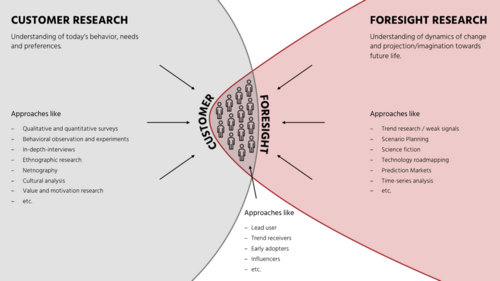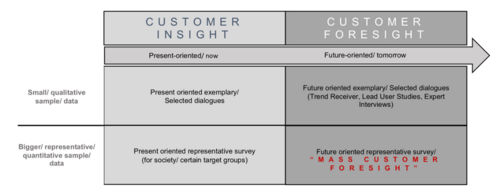Customer foresight
Customer foresight is a new[when?] field of applied research. It aims to understand future consumer preferences and wishes with regard to tomorrow's products and services. It does so by combining customer research and foresight research elements. Customer foresight can be conceived as an interaction with projected future markets through selected customers by understanding their wishes and attitudes, ideas and visions as well as their perception of signals and drivers of change. Even though the concept cannot predict the future, it enables companies to prepare for different future scenarios and thus improves strategy and decision-making processes.
Definition and classification
As the future combines both continuity and change, not everything one knows today will disappear tomorrow. Some things will change significantly while others will not.[1] But even today, research reveals that numerous inventions fail due to a lack of customer centricity.[2] Consequently, anticipating future customer needs and behaviors constitutes a challenge when developing future product portfolios. This is especially relevant for industries with long planning cycles because these industries have to develop value propositions today for the customers of tomorrow.[3] However, this involves dealing with many unknowns e.g. future everyday life or future consumption patterns. This is why, customer foresight starts with analyzing the consumer needs, values and motivations of today. Methods in the field of customer research that can be applied at this stage are e.g. qualitative and quantitative surveys, behavioral observation and experience, ethnographic research, cultural analysis or value and motivation research. On the basis of these consumer insights, transformations and change dynamics are projected into the future.[4] As a result, a space of possibility is defined.[5]
In order to then understand future realities, customer and foresight research are combined. Foresight tools to apply can for example be scenario planning, trend research and science fiction. However, also quantitative methods such as time series analysis can be used. Their application allows for understanding dynamics of change and projecting the envisioned developments into the future. The following graphic visualizes and classifies the approach in the sweet spot of customer and foresight research.[6]
At the intersection of customer and foresight research, it is then crucial to understand the interaction of customers with drivers of change or future realities. As customer foresight relies a lot on insight generation through interactions, a systematic selection of study participants is of great importance. Through interacting with Trend Receivers or other study participants, insights are generated which are then analyzed. The following section provides a more detailed description of the stages of typical customer foresight projects.
Stages of customer foresight projects
The customer foresight journey typically starts with the identification of relevant business needs by e.g. analyzing market dynamics, visions and objectives and value propositions. In a second step, change dynamics are analyzed and research materials on future scenarios are collected e.g. by applying scenario planning, doing desk research, roadmapping and gathering inputs from science fiction (for an example of a multi-method study approach in the field of customer foresight see Hahn et al. 2016).[7] Then, the most suitable dialogue partners and project participants are selected by applying pyramiding techniques, screening, scouting or broadcasting. The interviews can be organized in role-playing, workshop formats or in-depth interviews. Based on these inputs, practical implications are identified which are then integrated by decision makers through strategy workshops, backtesting or design thinking sprints.[6] As a consequence, customer foresight insights are transferred into business value.
Mass customer foresight
As the name already alludes, mass customer foresight is about insights that are valid for the mass market or the average customer and are representative for societies or markets. In contrast to customer foresight, it uses large scale, quantitative tools to examine future consumer behavior in a representative way. The following figure classifies the concept with regard to customer insight and foresight.
The concept was developed by Goethe University and the Foresight Academy as an extension to the customer foresight concept. The latter is often criticized as too elitist because the application of the e.g. Trend Receiver methodology by its definition implies that the subjects do not embody the average consumer. Since the customer base of many companies consists of the broad mass of people it can be important to enrich insights generated in the course of interactions with a selection of customers with the view of a representative sample. Consequently, the importance of these insights for corporate strategy formulation can be increased.
An example for such a mass customer foresight study is the research project which was carried out in the course of the collaboration between Goethe University and the Foresight Academy. Here, such a quantitative study was designed and carried out within Germany, China and the United States. The research project built on the results of a Trend Receiver study that examined the question “How do we want to live in 10 years?” within six areas of life: living, leisure and work; health and nutrition, consumption and finance; communication; identity and expression as well as community and society. The qualitative insights generated through the interviews were used as the hypotheses to validate within the joint quantitative survey. As a consequence, empirical research can approve or reject projections made and increase the validity of the qualitative results and their importance for corporate strategy and decision making.
While customer foresight itself is quite a new research field, mass customer foresight is even more new and still rather in the experimental stages. However, it will be interesting to observe its further development in theory and practice.
See also
References
- ↑ Hofmann, Rupert (2020). "Customer Foresight Practice. How to access future markets through extraordinary people". Marketing Review St. Gallen 3.
- ↑ Kleijnen, Mirella; Lee, Nick; Wetzels, Martin (2009). "An exploration of consumer resistance to innovation and its antecedents". Journal of Economic Psychology 30 (3): 344–357. doi:10.1016/j.joep.2009.02.004. ISSN 0167-4870.
- ↑ Hofmann, Rupert (2011). Trend-Receiver - qualifizierte Visionskraft Kriterien und Vorgehensweisen der Befragtenauswahl und Dialoggestaltung bei Studien zu zukünftigen Konzepten am Beispiel der Audi AG. ISBN 978-3-86955-782-3. OCLC 752935288.
- ↑ Schweitzer, Nicola; Hofmann, Rupert; Meinheit, Andreas (2019-07-01). "Strategic customer foresight: From research to strategic decision-making using the example of highly automated vehicles" (in en). Technological Forecasting and Social Change 144: 49–65. doi:10.1016/j.techfore.2019.04.004. ISSN 0040-1625. http://www.sciencedirect.com/science/article/pii/S0040162518305626.
- ↑ Hofmann, Rupert (2015-12-01). "Visionary competence for long-term development of brands, products, and services: The trend receiver concept and its first applications at Audi" (in en). Technological Forecasting and Social Change 101: 83–98. doi:10.1016/j.techfore.2014.06.005. ISSN 0040-1625. http://www.sciencedirect.com/science/article/pii/S0040162514001954.
- ↑ 6.0 6.1 Eller, Hofmann & Schwarz (2020). "The Customer Foresight Territory". Marketing Review St. Gallen 3.
- ↑ Hahn, Alexander; Hofmann, Rupert; Bilgram, Volker; Schwarz, Jan Oliver; Meinheit, Andreas; Füller, Johann (2016), Abele, Thomas, ed., "Easy Rider" (in de), Die frühe Phase des Innovationsprozesses: Neue, praxiserprobte Methoden und Ansätze, FOM-Edition (Wiesbaden: Springer Fachmedien): pp. 75–98, doi:10.1007/978-3-658-09722-6_5, ISBN 978-3-658-09722-6
 |



